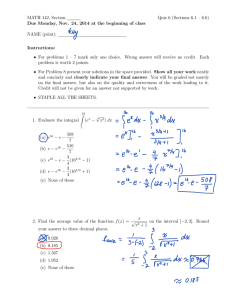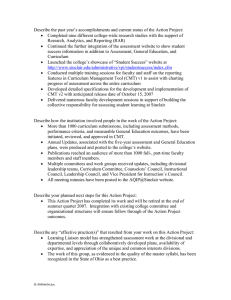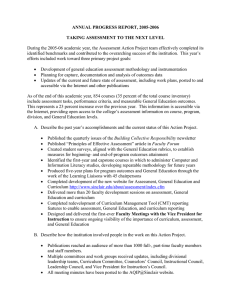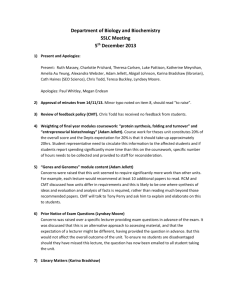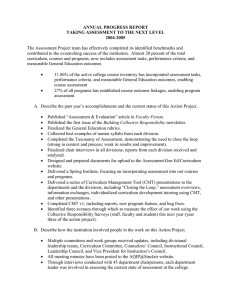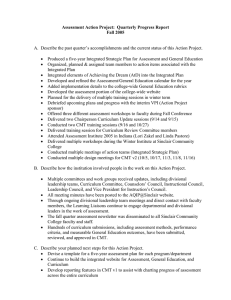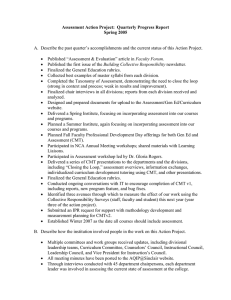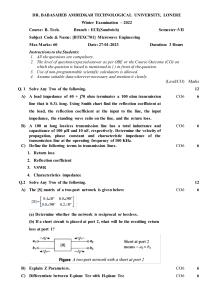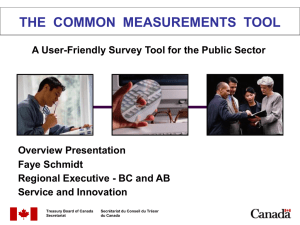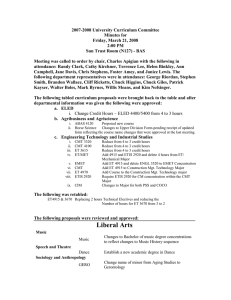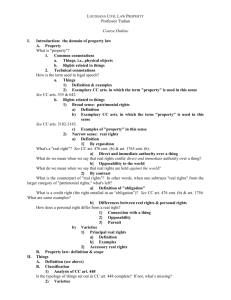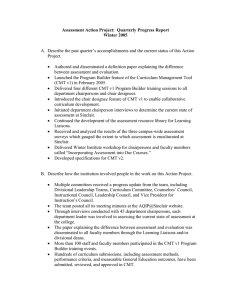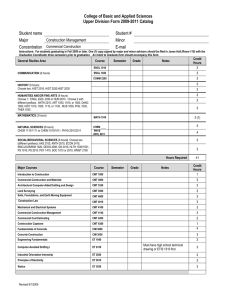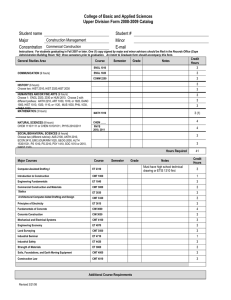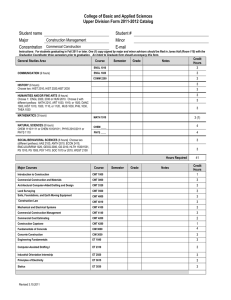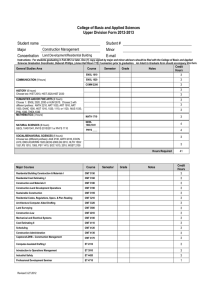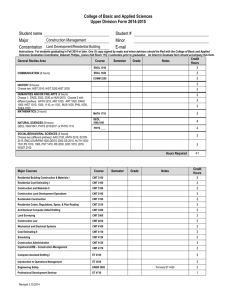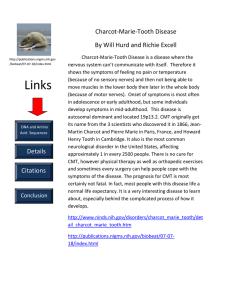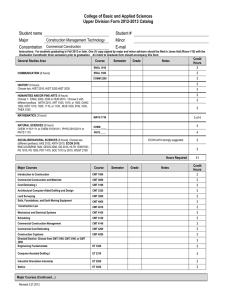Crisis Management System
advertisement
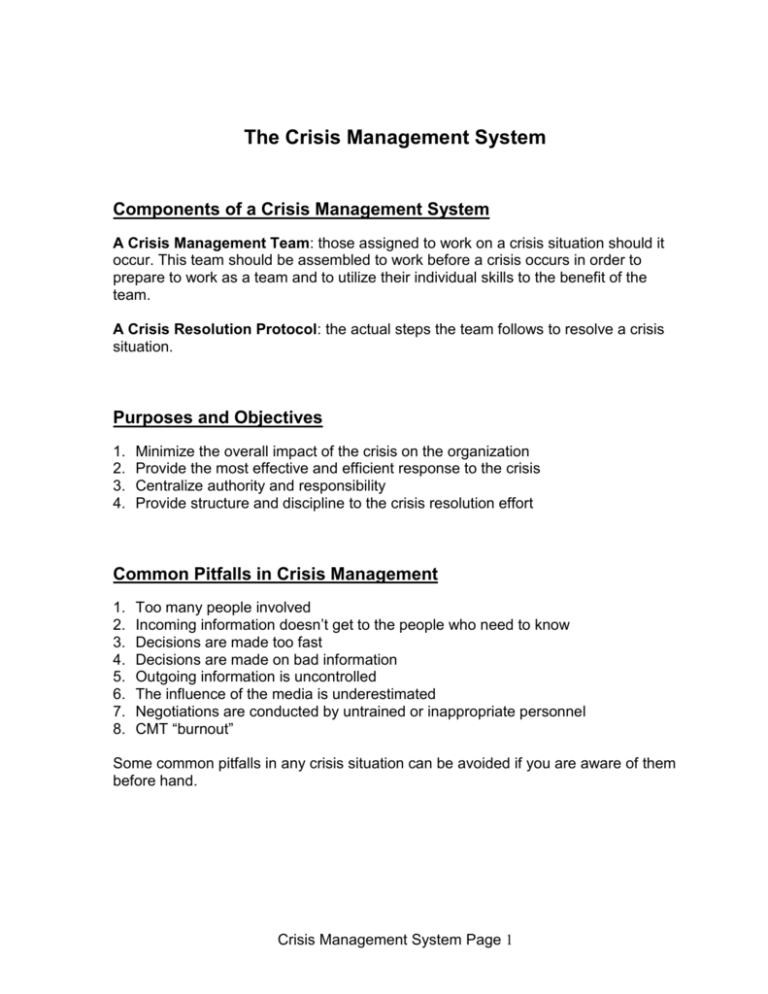
The Crisis Management System Components of a Crisis Management System A Crisis Management Team: those assigned to work on a crisis situation should it occur. This team should be assembled to work before a crisis occurs in order to prepare to work as a team and to utilize their individual skills to the benefit of the team. A Crisis Resolution Protocol: the actual steps the team follows to resolve a crisis situation. Purposes and Objectives 1. 2. 3. 4. Minimize the overall impact of the crisis on the organization Provide the most effective and efficient response to the crisis Centralize authority and responsibility Provide structure and discipline to the crisis resolution effort Common Pitfalls in Crisis Management 1. 2. 3. 4. 5. 6. 7. 8. Too many people involved Incoming information doesn’t get to the people who need to know Decisions are made too fast Decisions are made on bad information Outgoing information is uncontrolled The influence of the media is underestimated Negotiations are conducted by untrained or inappropriate personnel CMT “burnout” Some common pitfalls in any crisis situation can be avoided if you are aware of them before hand. Crisis Management System Page 1 Definitions Incident – an event of serious nature that deems reporting, but as yet no significant action is planned Emergency – a sudden occurrence of a serious and urgent nature that demands immediate action Crisis Situation – A protracted emergency that threatens the overall safety and security of the mission team, organization, and/or personnel, and is likely to demand an abnormal commitment of resources for an extended period of time requiring the activation of the Crisis Management Team Types of Crises Involved Any crisis event can involve a number of the types of crises listed. 1. 2. 3. 4. Natural disaster Medical emergency Political events Personnel events Phases of a Crisis Pre-Crisis Phase – Any time you are not in a crisis. This is the time to proactively take steps to avert a future crisis event, or to at least minimize the consequences of an event. This could include training and safety preparations on the field. Acute Phase – This is the time at which the organization must work together to initiate the resolution of the crisis. It is the most stressful time of the crisis. Crisis Resolution Phase – The steps are listed later in this document. Crisis Recovery Phase – This is post-crisis phase and the time to close the crisis. It is a time to determine any recuperation needs and to evaluate the resolution process. Crisis Management System Page 2 The Crisis Management Team Characteristics 1. A temporary task force consisting of as few members as possible. 2. It should be the ONLY part of the organization working on the crisis. 3. The members should represent a variety of approaches and strategies to problem solving, but they must show a united front in support of the CMT actions. Functions and Responsibilities 1. Security and safety of all organizational personnel affected by the crisis 2. Full assessment of the crisis, including developing and evaluating all relevant information 3. Developing and implementing the crisis response plan 4. All public information releases about the crisis are to be made by (or with the specific approval of) the Crisis Management Team. 5. Maintaining a complete record, which is important for: Potential litigation Reporting to family members 6. Evaluating the crisis when closing the crisis Staffing “Normal” Functional Areas (Some areas could be combined) 1. Crisis Manager - Overall responsibility for coordinating the crisis resolution process 2. Documentation Officer - Able to handle large volumes of information systematically 3. The Financial Officer – Responsible for handling any funds related to the crisis 4. The Logistics Officer – Responsible for the planning, implementation and coordination of the details of the crisis. 5. The Media Officer - Functions as the CMT contact to the media (serves the CMT, not the media). 6. The Negotiator - Specialized role requiring a person who can carry on negotiations under advisement Crisis Management System Page 3 Consultants or Advisors 1. Appropriate in many cases 2. Should never be decision-makers 3. Frequently include: Hostage negotiators Crisis Management specialists Legal advisors Media relations specialists Crisis Consulting International 9452 Telephone Road, #223 Ventura, CA 93004 U.S.A. Tel (+) 805-642-2549 Fax (+) 805-987-5192 Email info@CriCon.org The Crisis Resolution Process Step 1: Recognize and Acknowledge the Crisis Early detection of the crisis is critical for resolution Plan for the realistic “worst case” Step 2: Contain the Crisis Conduct an initial investigation Brainstorm - what else could go wrong and what are the chances it will? Look for all possible secondary crises; any crisis can get worse without containment Step 3: Isolate the Crisis Activate contingency plans Communicate to the organization Provide follow-up and reinforcement Crisis Management System Page 4 Step 4: Assess the Crisis Who? What? When? Where? Why? How? Step 5: Plan the Response Once the background work is complete and a crisis management team is in place a flexible plan can be developed. The elements necessary in preparing a response are: An effective retrieval and reporting system for the communications and reporting for the CMT Continually reassess the crises situation(s) and make necessary modifications Identify the most pressing crisis of the moment - the pivotal crisis Develop an action plan Identify intended results Determine your media style (open, closed, reserved) Step 6: Implement the Plan Write out your plan and include a complete description of the situation. List the specific steps that need to be taken along with specific assignments. Beware of independent actions Step 7: Evaluate and Modify the Plan Continually reassess the crisis situation(s) Measure actions against intended results Modify the plan as necessary with notifications of these modifications Step 8: Close the Crisis This is an opportunity to learn through critical review for the next time, NOT a time to point fingers. Recall all resources DEBRIEF Identify “consequences” Plan follow-up actions – thank you’s, counseling, and training Crisis Management System Page 5 CRISIS INFORMATION SHEET Ward Emergency Contact - Crisis Management Team The Crisis Call (When) 1. Person Calling: _________________________________________ 2. Date & Time of the call: __________________________________ 3. Date & Time of crisis: ____________________________________ 4. Country and phone # of call: _______________________________ ______________________________________________________ 5. Source of Information: ____________________________________ (Who) is in the Crisis Situation? Who is involved?___________________________________ Group Family Single Individual List the full names of all involved: Crisis Management System Page 6 (What) is the Nature of the Emergency/Crisis? Please check one below: ___ Accident ____Medical ____ Political (including terrorism) ___ Violence/crime ___ Natural disaster ____ Personal ___Other (specify) ____________________________ Other Information when Available and Appropriate: Level of personal danger: _____high _____medium _____low Level of help being administered: _____good _____moderate _____poor Source of help: _____ missionaries _____ Embassy or Consulate _____ nationals _____professionals _____ other (specify) __________________________________ Current status of situation: _____unresolved _____being resolved _____resolved (Who) is the Crisis Manager on the Field? Name: ________________________________________________ Phone number: _________________________________________ Position or Title: ________________________________________ Crisis Management System Page 7 (How) Did the Crisis Happen? Give a brief description of the crisis: (Where) Did the Crisis Happen? Location of crisis: _________________________________________ Location at present: _______________________________________ Name of closest city: ______________________________________ Name of best communication center:__________________________ Phone number: _____________________ Fax: _________________________ Damage or Injury Assessment: Description of damage: What was damaged? Where did damage occur? Explanation of medical situation: Who is ill or injured? What is the nature of the illness or injury? Crisis Management System Page 8
